How To Upload A Font To Use In Email Html
More than than one.1 billion people use Office. That's one in 7 people on the planet. Microsoft Outlook is the go-to email client for business organisation and a stunning number of users use it in everyday work. It is a very powerful electronic mail client, but sometimes this power is a shortcoming.
I such case is using Microsoft Outlook to send HTML-formatted newsletters or forms. "But Outlook allows me to create HTML-formatted messages using a lot of controls and styles," y'all might say, and you would be 100% right. Only as shortly as yous try to create an HTML message using special software and utilise the resulting HTML as a source for your message, y'all volition be surprised: Outlook doesn't allow you to use your own HTML source to build a message! "OK, just it is not a large problem" – yous say, and once again you may exist right because you can open the resulting HTML message using Internet Explorer and copy-northward-paste the data through the clipboard into the Outlook bulletin. Yes, this can be done, simply in that location is a surprise waiting for you.
Beginning with Role 2007, Outlook simply supports Microsoft Word as an engine for generation and display of messages in HTML format. The previous versions of Microsoft Outlook used Net Explorer every bit an HTML engine. These technical changes cause significant differences in both the appearance of the resulting message as well as in the HTML code itself, which undergoes alterations and corrections. At first glance, this does not seem to exist a big problem… but only at commencement glance.
Why is information technology so important to save the initial HTML code of emails?
The reply to this question is very simple – to be certain that your HTML email will look the same in Microsoft Outlook and in Google Mail, Apple Mail and in electronic mail clients on tables and mobile devices. By creating an HTML email using an HTML editor that is not Microsoft Word or Outlook, you have the chance to test how the lawmaking will brandish in various browsers and post clients. For example, you can apply a gratis online service from Litmus Software which will let you exam your HTML code's appearance in more thirteen email clients: hhttps://world wide web.litmus.com/email-testing/
Using an HTML editor along with a testing and optimization tool like this, you can create rather complex HTML messages and be confident that they will announced properly for all recipients. But this remains the example only so long as your HTML source code stays in its initial course. Every bit soon as you put your code into Microsoft Outlook through the exchange buffer, the whole code volition be transformed and corrected.
What is the HTML body of the bulletin?
We'll create a simple HTML file:
<html>
Hi <b>Globe</b>!
</html>
The file size is 36 bytes. We open this file in Microsoft Word equally HTML and relieve information technology every bit HTML with a different proper name. We see that the size of the resulting file is 35.8Kb! But like that, the file size increased 1000 times! Simply it looks the exact same as before. To clarify what the differences are, let'southward look at the source of this new HTML file:
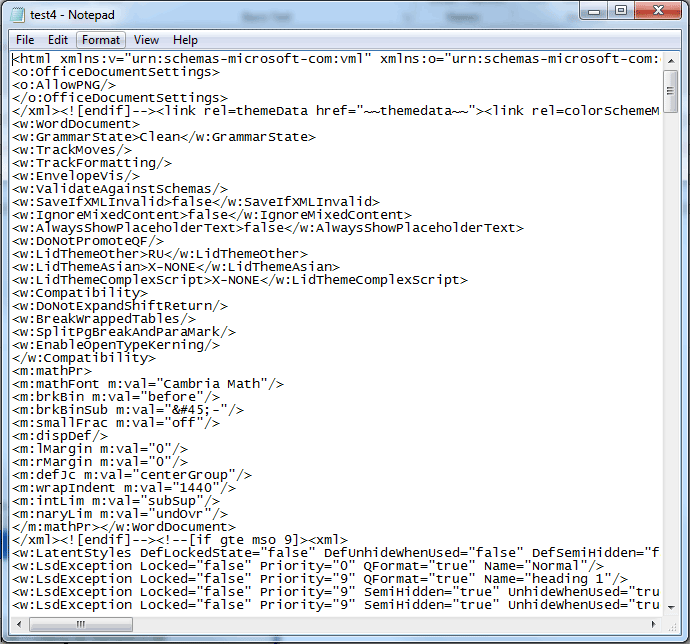
So we see that our simple HTML text has been enriched with a huge mass of 'garbage' that has come seemingly from out of nowhere, and which is many times greater than that original text in its initial format. After this transformation, we can no longer exist sure that this lawmaking volition appear the way that we desire it to.
Why does Give-and-take change initial HTML code in the email body?
These changes occur because Microsoft Give-and-take is not an HTML editor; it only allows the import of files of that format. That ways that the source text was imported into Microsoft Word so exported back out every bit HTML created at the fourth dimension of saving the document – and the minimum file size for this HTML is 35 Kb. But that is when the HTML format is called when saving. There is, actually, a fashion for Microsoft Give-and-take to salve in a unlike format, called HTML-filtered, which volition filter out most of the added garbage. This method results in a file of 5Kb, which is all the same x times more than the original source file.
Notation that although we are discussing Microsoft Discussion, all of this concerns Microsoft Outlook also, since the aforementioned HTML engine is used in both products. The HTML-filtered format is what is used when generating emails in HTML for Outlook. This means that Microsoft Outlook simple does non let united states to create a message in HTML that is less than 5Kb (and that is an empty bulletin).
This transformation of the message past the Outlook editor is some other drawback of the product. Imagine a situation where the template of a weekly newsletter is created using an HTML-editor to avert destroying the HTML formatting of the document when importing and exporting it using Word. When this document is placed into the body of the bulletin in the Outlook editor (using the copy-n-paste option), our HTML lawmaking will exist transformed and made much more circuitous, which tin can destroy the initial formatting and display the document incorrectly when it is received by other email clients and browsers.
Microsoft Outlook does non provide whatever options to send messages without transforming the HTML torso. There are some plug-ins in the software market that allow editing of the message trunk in HTML, thus avoiding transformation. But these, unfortunately, do not solve the problem, because Microsoft Outlook still executes the transformation as soon as you click "Send". This means that information technology is no difference between creating a nice-looking HTML electronic mail in a special HTML-editor and pasting it into the message via the substitution buffer and then sending the electronic mail, and using a special plan to let you paste HTML code in its initial format when creating the email. In both cases, the recipient receives a larger and reformatted bulletin.
How can i relieve the initial HTML source code?
Regardless of the limitations of Microsoft Outlook, in that location is still the possibility to send an electronic mail with its initial formatting without executing an HTML transformation. This can be done using the Transport Personally, which is a Microsoft Outlook add together-in designed to send mailing lists with personalized greetings – which is very user-friendly in newsletters, announcements, and promotions. Merely correct now, we are well-nigh interested in this program for its power to piece of work with the HTML source of the message body.
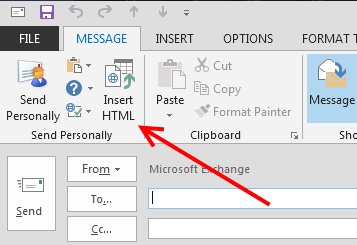
This plan adds an Insert HTML to the ribbon in the message editor section; this option appears when nosotros create a new email or answer an existing email. When we click on the Insert HTML button, a window opens, showing the HTML source of the current bulletin. In this window, nosotros can create HTML code for the message and edit it. Even if we accept but created a new electronic mail and have non nevertheless written annihilation in the body of the message, we can click on the Insert HTML button and nosotros see that Outlook has already put in all the 'necessary' HTML coding in:
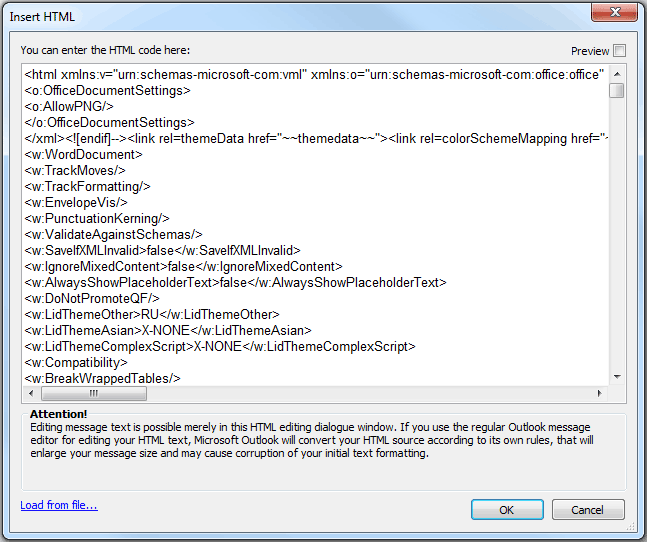
Using this window, we can only select the whole text that has been added past the Outlook editor and replace information technology with our own, using either the exchange buffer or the "Load from file…" pick.
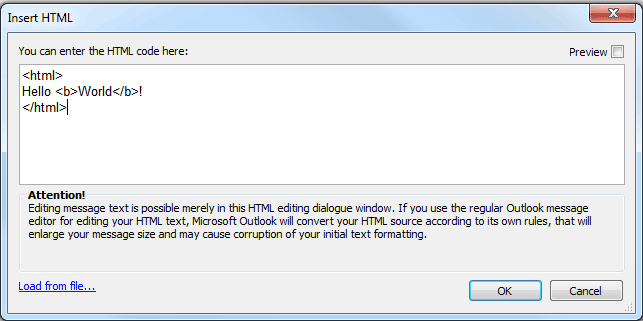
You can so use the Preview option to come across the resulting HTML, or click OK to save the new text in the bulletin trunk. Note that nosotros cannot edit the text in the message using the Outlook editor, considering Outlook will immediately transform our source HTML. If we need to acquit out further modifications in the message, then we volition demand to click the Insert HTML button again and brand the changes in the window.
At this point, we have created an email and not immune Outlook to transform the source HTML, but this is only the first footstep. Next, we need to prevent modification to the bulletin when the Send button is clicked. This task is performed using the Send Personally button. The consequence is that this program sends messages through the MAPI system and does non telephone call the handler which is triggered when the Transport button is pressed. With the Transport push button never existence clicked, no transformation occurs. So all the needs to exist done is to press the Transport Personally button instead of Transport.
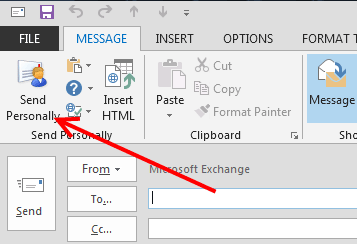
Before long, this is the merely way to transport an HTML email from Microsoft Outlooks and preserve the original HTML formatting. To verify this, go to the Sent binder of Microsoft Outlook and double-click on the bulletin to view it, and and then correct-click on the message body and cull the View source option. Doing this, we see:
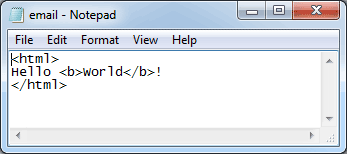
There are 2 central points to think here:
- The email can merely be edited in the HTML editing window. This is true for any modification. Outlook volition change 'our' HTML to its own HTML even if we just change the user account from which the e-mail is sent.
- The bulletin must be sent using the Send Personally button, not using Send.
Video tutorial on how to send HTML emails unchanged by Outlook
Scout this step-by-step guide on Insert HTML feature to learn how to prevent Outlook from altering the HTML content of outgoing messages past using the.
Source: https://www.mapilab.com/blog/insert-html-into-outlook-email-message/
Posted by: kimourich.blogspot.com

0 Response to "How To Upload A Font To Use In Email Html"
Post a Comment